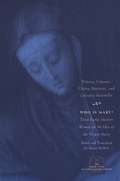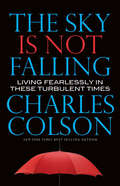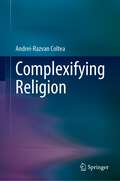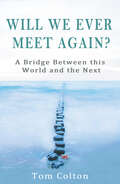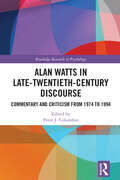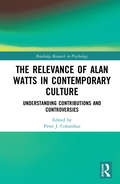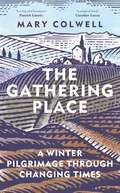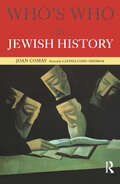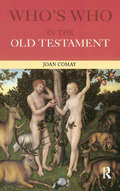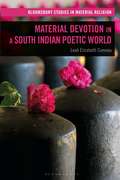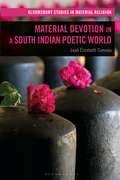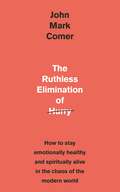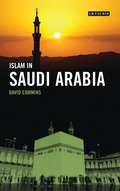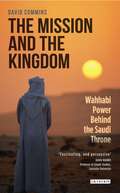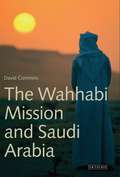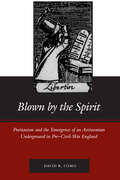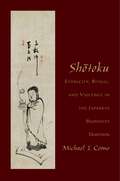- Table View
- List View
Who Is Mary?: Three Early Modern Women on the Idea of the Virgin Mary (The Other Voice in Early Modern Europe)
by Vittoria Colonna Chiara Matraini Lucrezia MarinellaFor women of the Italian Renaissance, the Virgin Mary was one of the most important role models. Who Is Mary? presents devotional works written by three women better known for their secular writings: Vittoria Colonna, famed for her Petrarchan lyric verse; Chiara Matraini, one of the most original poets of her generation; and the wide-ranging, intellectually ambitious polemicist Lucrezia Marinella. At a time when the cult of the Virgin was undergoing a substantial process of redefinition, these texts cast fascinating light on the beliefs of Catholic women in the Renaissance, and also, in the cases of Matraini and Marinella, on contemporaneous women’s social behavior, prescribed for them by male writers in books on female decorum. Who Is Mary? testifies to the emotional and spiritual relationships that women had with the figure of Mary, whom they were required to emulate as the epitome of femininity. Now available for the first time in English-language translation, these writings suggest new possibilities for women in both religious and civil culture and provide a window to women’s spirituality, concerning the most important icon set before them, as wives, mothers, and Christians.
Who Is Mary?: Three Early Modern Women on the Idea of the Virgin Mary (The Other Voice in Early Modern Europe)
by Vittoria Colonna Chiara Matraini Lucrezia MarinellaFor women of the Italian Renaissance, the Virgin Mary was one of the most important role models. Who Is Mary? presents devotional works written by three women better known for their secular writings: Vittoria Colonna, famed for her Petrarchan lyric verse; Chiara Matraini, one of the most original poets of her generation; and the wide-ranging, intellectually ambitious polemicist Lucrezia Marinella. At a time when the cult of the Virgin was undergoing a substantial process of redefinition, these texts cast fascinating light on the beliefs of Catholic women in the Renaissance, and also, in the cases of Matraini and Marinella, on contemporaneous women’s social behavior, prescribed for them by male writers in books on female decorum. Who Is Mary? testifies to the emotional and spiritual relationships that women had with the figure of Mary, whom they were required to emulate as the epitome of femininity. Now available for the first time in English-language translation, these writings suggest new possibilities for women in both religious and civil culture and provide a window to women’s spirituality, concerning the most important icon set before them, as wives, mothers, and Christians.
Who Is Mary?: Three Early Modern Women on the Idea of the Virgin Mary (The Other Voice in Early Modern Europe)
by Vittoria Colonna Chiara Matraini Lucrezia MarinellaFor women of the Italian Renaissance, the Virgin Mary was one of the most important role models. Who Is Mary? presents devotional works written by three women better known for their secular writings: Vittoria Colonna, famed for her Petrarchan lyric verse; Chiara Matraini, one of the most original poets of her generation; and the wide-ranging, intellectually ambitious polemicist Lucrezia Marinella. At a time when the cult of the Virgin was undergoing a substantial process of redefinition, these texts cast fascinating light on the beliefs of Catholic women in the Renaissance, and also, in the cases of Matraini and Marinella, on contemporaneous women’s social behavior, prescribed for them by male writers in books on female decorum. Who Is Mary? testifies to the emotional and spiritual relationships that women had with the figure of Mary, whom they were required to emulate as the epitome of femininity. Now available for the first time in English-language translation, these writings suggest new possibilities for women in both religious and civil culture and provide a window to women’s spirituality, concerning the most important icon set before them, as wives, mothers, and Christians.
The Sky Is Not Falling: Living Fearlessly in These Turbulent Times
by Charles ColsonChuck Colson equips readers to live fearlessly, with confidence in God's love and ultimate power, in the midst of an increasingly godless world.Yes, the world is an increasingly godless place. And it's never been as pronounced as it is in this era of 24-hour news cycles. From nasty political power struggles to raunchy reality TV, everywhere we look there is evidence of our culture's steep decline. But it's no time for Christians to cower in fear. In The Sky Is Not Falling, bestselling author Chuck Colson equips readers with the truth about the most difficult cultural and moral issues of our day and brings clarity and sanity to a world that seems to have gone mad. His message is that Christians must be informed of the truth of today's confusing social and political issues so that we can live with the confidence and certainty that God has the future in his hands. Every concerned Christian needs to arm themselves with the profound insights in The Sky is Not Falling.
Complexifying Religion
by Andrei-Razvan ColteaThis book provides an original and challenging perspective of religions as abstract complex adaptive systems, using an interdisciplinary approach to try to understand what religions are and how they function, two fundamental issues which, despite an intense struggle from several fields, have not yet been resolved. What is the source of religious belief? How do religions work and what are they made of? Why is religion so important for us that it has survived centuries of scientific progress and secularization? Why are people religious even outside religion? The book addresses these questions using an interdisciplinary approach that seeks to untangle the Gordian knot of defining religion. In short, they can be considered entropy-reducing technologies. What differentiates them from other meaning-producing systems is their configuration which employs specific building blocks as tools for mitigating entropy, which are also subsystems and combine in various ways to build a unique configuration: rituals, myths, taboos, supernatural agents, authority, identity, superstitions, moral obligations, afterlife beliefs and the sacred. As a reaction to perturbances or pressure, systems can collapse. Inspired by Nicholas Nassim Taleb, it is, in this book, referred to as fragility—the negative reaction of systems to random events, and four parameters can be used to evaluate it in religious systems: monotonicity (the inability to learn from past mistakes), coupling (linking with other systems: such as political or economic), centralization and stress starvation. Several case studies are provided in order to test the theoretical claims made in this book, based on the author's field research in Romania, Japan, North Korea and Mongolia, and offering details that could be of interest to casual readers, students and researchers of religion.
Will We Ever Meet Again?: A Bridge Between this World and the Next
by Tom ColtonDo you ever wonder what happens after death? Do you believe in life after death? In this candid and straight-talking book, the author shares his own journey into mediumship and his work with various development circles and other groups. We get a unique insight into the challenges of this very unconventional calling, as Tom performs 'spirit rescues' in homes troubled by persistent spirit activity and helps families reconcile with the loss of loved ones. But this book is not just about Tom's journey, or the poignant stories of the clients he has helped. His aim is also to show the reader that, far from there being any special 'gift' required, the ability to connect with the Spirit World is one which each and every one of us can develop and make use of. Filled with compassion, humour and pragmatism, this book opens up the world of mediumship and Spirit to us all.
Alan Watts in Late-Twentieth-Century Discourse: Commentary and Criticism from 1974-1994 (Routledge Research in Psychology)
by Peter J. ColumbusThis book is an anthology of commentary and criticism written within the transitional period between Alan Watts’ 1973 death and the twenty-first century intellectual horizon. Comprised of 16 chapters written and published between 1974 and 1994, with up-to-date introductions from the essayists and other contemporary thinkers, this volume opens a window onto unexplored grounds of Alan Watts’ impact within late-twentieth-century discourse – an intermediate space where scholars reoriented their bearings through changing times and emerging academic trends. Offering varied explanations and assessments of Alan Watts, including his influence on the Beat and Hippie generations, and his popularization of Zen Buddhism in America, it tackles unaddressed questions within the milieu of late-twentieth-century America from the Reagan Revolution and religious conservatism, to paradigm shifts in Buddhist studies and the rise of post-colonial theory. Contributors’ post-mortem analyses and critiques of Watts allow for a thematic rendering of their consonance or dissonance with noted Beat, Hippie, and Zen Buddhism themes of his lifetime. This volume will appeal to scholars and students of humanistic psychology, transpersonal psychology, the psychology of religion, comparative religion, and American studies.
The Relevance of Alan Watts in Contemporary Culture: Understanding Contributions and Controversies (Routledge Research in Psychology)
by Peter J. ColumbusWhilst accounting for the present-day popularity and relevance of Alan Watts’ contributions to psychology, religion, arts, and humanities, this interdisciplinary collection grapples with the ongoing criticisms which surround Watts’ life and work. Offering rich examination of as yet underexplored aspects of Watts’ influence in 1960s counterculture, this volume offers unique application of Watts’ thinking to contemporary issues and critically engages with controversies surrounding the commodification of Watts’ ideas, his alleged misreading of Biblical texts, and his apparent distortion of Asian religions and spirituality. Featuring a broad range of international contributors and bringing Watts’ ideas squarely into the contemporary context, the text provides a comprehensive, yet nuanced exploration of Watts’ thinking on psychotherapy, Buddhism, language, music, and sexuality. This text will benefit researchers, doctoral students, and academics in the fields of psychotherapy, phenomenology, and the philosophy of psychology more broadly. Those interested in Jungian psychotherapy, spirituality, and the self and social identity will also enjoy this volume.
The Relevance of Alan Watts in Contemporary Culture: Understanding Contributions and Controversies (Routledge Research in Psychology)
by Peter J. ColumbusWhilst accounting for the present-day popularity and relevance of Alan Watts’ contributions to psychology, religion, arts, and humanities, this interdisciplinary collection grapples with the ongoing criticisms which surround Watts’ life and work. Offering rich examination of as yet underexplored aspects of Watts’ influence in 1960s counterculture, this volume offers unique application of Watts’ thinking to contemporary issues and critically engages with controversies surrounding the commodification of Watts’ ideas, his alleged misreading of Biblical texts, and his apparent distortion of Asian religions and spirituality. Featuring a broad range of international contributors and bringing Watts’ ideas squarely into the contemporary context, the text provides a comprehensive, yet nuanced exploration of Watts’ thinking on psychotherapy, Buddhism, language, music, and sexuality. This text will benefit researchers, doctoral students, and academics in the fields of psychotherapy, phenomenology, and the philosophy of psychology more broadly. Those interested in Jungian psychotherapy, spirituality, and the self and social identity will also enjoy this volume.
The Gathering Place: A Winter Pilgrimage Through Changing Times
by Mary Colwell'Deeply poetic.' CAROLINE LUCAS MP'A masterpiece of storytelling.' NICK MAYHEW-SMITH'Mary Colwell is a candle of open-minded curiosity.' PATRICK LAURIE'An unforgettable story.' MICHAEL MCCARTHY'Inspiring.' JEREMY MYNOTT-Mary Colwell makes a 500-mile solo pilgrimage along the Camino Francés, winding through forests, mountains, farmland, industrial sprawls and places of worship, weaving her experiences of the Camino with natural history, spirituality and modern environmentalism.Pilgrims have always walked in times of upheaval, pitching themselves against weather, hunger, thirst and sometimes pain as they tread the paths their ancestors followed before them. In The Gathering Place, author, nature campaigner and veteran solo walker Mary Colwell undertakes a 500-mile pilgrimage along the Camino Francés in northern Spain at a unique moment in history – a time of pandemic, profound political change, and a climate and biodiversity emergency. In a typical year, more than 300,000 people walk this route or part of it, but in between lockdowns in 2020, Mary was virtually alone. The modern world weaves in and out of the Camino's worn trackway, providing a focus for contemplation and a place where memories and experiences can gather. There are times of intense spirituality, meetings with a demon slayer, strange goings-on and magical tales, and the constant backdrop of nature with all its complexity and wonder. In this delightful book, Mary's winter pilgrimage weaves a personal tale with a walk that millions have undertaken over the centuries. The Gathering Place is a beautiful, thoughtful and, at times, humorous journey of both body and soul.
The Gathering Place: A Winter Pilgrimage Through Changing Times
by Mary Colwell'Deeply poetic.' CAROLINE LUCAS MP'A masterpiece of storytelling.' NICK MAYHEW-SMITH'Mary Colwell is a candle of open-minded curiosity.' PATRICK LAURIE'An unforgettable story.' MICHAEL MCCARTHY'Inspiring.' JEREMY MYNOTT-Mary Colwell makes a 500-mile solo pilgrimage along the Camino Francés, winding through forests, mountains, farmland, industrial sprawls and places of worship, weaving her experiences of the Camino with natural history, spirituality and modern environmentalism.Pilgrims have always walked in times of upheaval, pitching themselves against weather, hunger, thirst and sometimes pain as they tread the paths their ancestors followed before them. In The Gathering Place, author, nature campaigner and veteran solo walker Mary Colwell undertakes a 500-mile pilgrimage along the Camino Francés in northern Spain at a unique moment in history – a time of pandemic, profound political change, and a climate and biodiversity emergency. In a typical year, more than 300,000 people walk this route or part of it, but in between lockdowns in 2020, Mary was virtually alone. The modern world weaves in and out of the Camino's worn trackway, providing a focus for contemplation and a place where memories and experiences can gather. There are times of intense spirituality, meetings with a demon slayer, strange goings-on and magical tales, and the constant backdrop of nature with all its complexity and wonder. In this delightful book, Mary's winter pilgrimage weaves a personal tale with a walk that millions have undertaken over the centuries. The Gathering Place is a beautiful, thoughtful and, at times, humorous journey of both body and soul.
Who's Who in Jewish History (Who's Who Ser.)
by Joan ComayFrom Karl Marx to the Marx brothers, the Routledge Who's Who in Jewish History presents a complete reference guide to over a thousand prominent men and women who have shaped Jewish culture. Covering twenty centuries of Jewish history it provides:* detailed biographical information on each leading figure* analysis of their role and significance both in Jewish life and the wider culture* a comprehensive chronological table displaying the history of the Jewish race* a useful glossary giving precise definitions of Jewish words.
Who's Who in Jewish History: After The Period Of The Old Testament (Who's Who Ser.)
by Joan ComayFrom Karl Marx to the Marx brothers, the Routledge Who's Who in Jewish History presents a complete reference guide to over a thousand prominent men and women who have shaped Jewish culture. Covering twenty centuries of Jewish history it provides:* detailed biographical information on each leading figure* analysis of their role and significance both in Jewish life and the wider culture* a comprehensive chronological table displaying the history of the Jewish race* a useful glossary giving precise definitions of Jewish words.
Who's Who in the Old Testament
by Joan ComayWho's Who in the Old Testament brings vividly to life the thousands of characters in the Old Testament, and provides:* nearly 3000 extensive entries covering every character* detailed biographical information on each character, including exactly where to find them in the Bible* the complete historical, geographical and archaeological context of each entry* comprehensive chronology of the times* a section on the Apocrypha - the collection of works that bridges the gap between the Old and New Testaments.
Who's Who in the Old Testament: Together With The Apocrypha
by Joan ComayWho's Who in the Old Testament brings vividly to life the thousands of characters in the Old Testament, and provides:* nearly 3000 extensive entries covering every character* detailed biographical information on each character, including exactly where to find them in the Bible* the complete historical, geographical and archaeological context of each entry* comprehensive chronology of the times* a section on the Apocrypha - the collection of works that bridges the gap between the Old and New Testaments.
Material Devotion in a South Indian Poetic World (PDF)
by Leah ComeauMaterial Devotion in a South Indian Poetic World contributes new methods for the study and interpretation of material religion found within literary landscapes. The poets of Hindu devotion are known for their intimate celebration of deities, and while verses over a thousand years old are still treasured, translated, and performed, little attention has been paid to the evocative sensorial worlds referenced by these literary compositions. This book offers a material interpretation of an understudied poem that defined an entire genre of South Asian literature -Tirukkovaiyar-the 9th-century Tamil poem dedicated to Shiva.The poetry of Tamil South India invites travel across real and imagined geography, naming royal patrons, ancient temple towns, and natural landscapes. Leah Elizabeth Comeau locates the materiality of devotion to Shiva in a world unique to the South Indian vernacular and yet captivating to audiences across time, place, and tradition.
Material Devotion in a South Indian Poetic World (Bloomsbury Studies in Material Religion)
by Leah Elizabeth ComeauMaterial Devotion in a South Indian Poetic World contributes new methods for the study and interpretation of material religion found within literary landscapes. The poets of Hindu devotion are known for their intimate celebration of deities, and while verses over a thousand years old are still treasured, translated, and performed, little attention has been paid to the evocative sensorial worlds referenced by these literary compositions. This book offers a material interpretation of an understudied poem that defined an entire genre of South Asian literature -Tirukkovaiyar-the 9th-century Tamil poem dedicated to Shiva.The poetry of Tamil South India invites travel across real and imagined geography, naming royal patrons, ancient temple towns, and natural landscapes. Leah Elizabeth Comeau locates the materiality of devotion to Shiva in a world unique to the South Indian vernacular and yet captivating to audiences across time, place, and tradition.
The Ruthless Elimination of Hurry: How to stay emotionally healthy and spiritually alive in the chaos of the modern world
by John Mark ComerWho are you becoming? That was the question nagging pastor and author John Mark Comer. By outward metrics, everything appeared successful. But inwardly, things weren't pretty. So he turned to a trusted mentor for guidance and heard these words: 'Ruthlessly eliminate hurry from your life. Hurry is the great enemy of the spiritual life.' It wasn't the response he expected, but it continues to be the answer he needs.Too often we treat the symptoms of toxicity in our modern world instead of trying to pinpoint the cause. A growing number of voices are pointing at hurry, or busyness as a root of much evil. Within the pages of this book, you'll find a compelling emotional and spiritual case against hurry and in favour of a slower, simpler way of life.
Islam in Saudi Arabia (Islam in Series)
by David ComminsThe common image of Saudi Arabia portrays a country where religious rules dictate every detail of daily life: where women may not drive; where unrelated men and women may not interact; where the latter veil their faces; and where banks, restaurants and cafes have dual facilities: one for families, another for men. Yet life in the kingdom, contrary to perception, is not so clear cut as simply obeying dogma. David Commins challenges the stereotype of a country immune to change by highlighting the ways that urbanization, education, consumerism, global communications and technological innovation have exerted pressure against rules issued by the religious establishment. He places the Wahhabi movement in the wider context of Islamic history, showing how state-appointed clerics built on dynastic backing to fashion a model society of Sharia observance and moral virtue. But beneath a surface appearance of obedience to Islamic authority he detects currents that reflect Arabia's heritage of diversity (where Shi'i and Sufi tendencies survive in the face of discrimination) and the effects of its exposure to Western mores.
The Mission and the Kingdom: Wahhabi Power Behind the Saudi Throne
by David ComminsIn the wake of September 11th instant theories have emerged that try to root Osama Bin Laden's attacks on Wahhabism. Muslim critics have dismissed this conservative interpretation of Islam that is the official creed of Saudi Arabia as an unorthodox innovation that manipulated a suggestible people to gain political influence. David Commins' book questions this assumption. He examines the debate on the nature of Wahhabism, and offers original findings on its ascendance in Saudi Arabia and spread throughout other parts of the Muslim world such as Afghanistan and Pakistan. He also assesses the challenge that radical militants within Saudi Arabia pose to the region, and draws conclusions which will concern all those who follow events in the Kingdom. The Wahhabi Mission and Saudi Arabia is essential reading for anyone interested in the Middle East and Islamic radicalism today.
The Wahhabi Mission and Saudi Arabia (Library of Modern Middle East Studies #50)
by David ComminsThe history of the Wahhabis' close, loyal alliance with the ancestors of the present Saudi royal family has been recounted in fascinating, and persuasive detail by David Commins. His conclusion is no less startling as it is important, that Wahhabi hegemony over regional religious culture is in jeopardy; its credibility debased, possibly no longer able to buttress the Saudi dynasty's legitimacy. Whatever their future, the story of the Wahhabis has been told with authority and clarity by Commins in this absorbing book. - David Waines, Professor of Islamic Studies, Lancaster University'David Commins' careful, comprehensive and erudite account of Wahhabism in Saudi Arabia could not have come at a more opportune time. After so many tendentious and uninformed treatments of the subject in recent years, it is a pleasure to read a real historian's account, based upon original Arabic sources. Everyone involved in the public debate about Saudi Arabia's role in the Muslim world should read this book.'-F. GREGORY GAUSE, UNIVERSITY OF VERMONT'David Commins' work makes major contributions toward understanding the historical development of Wahhabism, particularly in the 19th century. His analysis of 19th century Wahhabi thought demonstrates the interplay between religion and politics during this critical time, setting the stage for the 20th century founding of the contemporary Kingdom of Saudi Arabia.'-NATANA J. DELONG-BAS, GEORGETOWN UNIVERSITY, AUTHOR OF WAHHABI ISLAM: FROM REVIVAL AND REFORM TO GLOBAL JIHAD (I.B.TAURIS)
The Wahhabi Mission and Saudi Arabia
by David ComminsThis book reveals the theories that inspire al-Qaeda. There is no other accessible book on the subject. This is the sect that threatens the stability of Saudi Arabia and the Middle East. Wahhabism has been generating controversy since it first emerged in Arabia in the 18th century. In the wake of September 11th instant theories have emerged that try to root Osama Bin Laden's attacks on Wahhabism. Muslim critics have dismissed this conservative interpretation of Islam that is the official creed of Saudi Arabia as an unorthodox innovation that manipulated a suggestible people to gain political influence. David Commins' book questions this assumption. He examines the debate on the nature of Wahhabism, and offers original findings on its ascendance in Saudi Arabia and spread throughout other parts of the Muslim world such as Afghanistan and Pakistan. He also assesses the challenge that radical militants within Saudi Arabia pose to the region, and draws conclusions which will concern all those who follow events in the Kingdom. "The Wahhabi Mission and Saudi Arabia" is essential reading for anyone interested in the Middle East and Islamic radicalism today.
Blown by the Spirit: Puritanism and the Emergence of an Antinomian Underground in Pre-Civil-War England
by David R. ComoThis study explores the intersection of politics, religious thought, and religious culture in pre-revolutionary England, using hitherto unknown or overlooked manuscripts and printed material to reconstruct and contextualize a forgotten but highly significant antinomian religious subculture that evolved at the margins of the early seventeenth-century puritan community. By reconstructing this story, Blown by the Spirit offers a major revision of current understanding of Puritanism and the puritan community. In the process, the author illuminates the obscure and tangled question of the origins of civil-war radicalism, thereby helping to explain the course, consequences, and ultimate failure of the English revolution.
Shotoku: Ethnicity, Ritual, and Violence in the Japanese Buddhist Tradition
by Michael I. ComoPrince Shotoku (573?-622?), the purported founder of Japanese Buddhism, is widely referred to as Japan's first national hero. The cult that grew up around his memory is recognized as one of the most important phenomena in early Japanese religion. This book examines the creation and evolution of the Shotoku cult over the roughly 200 years following his deatha period that saw a series of revolutionary developments in the history of Japanese religion. Michael Como highlights the activities of a cluster of kinship groups who claimed descent from ancestors from the Korean kingdom of Silla. He skillfully places these groups in their socio-cultural context and convincingly demonstrates their pivotal role in bringing continental influences to almost every aspect of government and community ideology in Japan. He argues that these immigrant kinship groups were not only responsible for the construction of the Shotoku cult, but were also associated with the introduction of the continental systems of writing, ritual, and governance. By comparing the ancestral legends of these groups to the Shotoku legend corpus and Imperial chronicles, Como shows that these kinship groups not only played a major role in the formation of the Japanese Buddhist tradition, they also to a large degree shaped the paradigms in terms of which the Japanese Imperial cult and the nation of Japan were conceptualized and created. Offering a radically new picture of the Asuko and Nara period (551794), this innovative work will stimulate new approaches to the study of early Japanese religion focusing on the complex interactions among ideas of ethnicity, lineage, textuality, and ritual.
Shotoku: Ethnicity, Ritual, and Violence in the Japanese Buddhist Tradition
by Michael I. ComoPrince Shotoku (573?-622?), the purported founder of Japanese Buddhism, is widely referred to as Japan's first national hero. The cult that grew up around his memory is recognized as one of the most important phenomena in early Japanese religion. This book examines the creation and evolution of the Shotoku cult over the roughly 200 years following his deatha period that saw a series of revolutionary developments in the history of Japanese religion. Michael Como highlights the activities of a cluster of kinship groups who claimed descent from ancestors from the Korean kingdom of Silla. He skillfully places these groups in their socio-cultural context and convincingly demonstrates their pivotal role in bringing continental influences to almost every aspect of government and community ideology in Japan. He argues that these immigrant kinship groups were not only responsible for the construction of the Shotoku cult, but were also associated with the introduction of the continental systems of writing, ritual, and governance. By comparing the ancestral legends of these groups to the Shotoku legend corpus and Imperial chronicles, Como shows that these kinship groups not only played a major role in the formation of the Japanese Buddhist tradition, they also to a large degree shaped the paradigms in terms of which the Japanese Imperial cult and the nation of Japan were conceptualized and created. Offering a radically new picture of the Asuko and Nara period (551794), this innovative work will stimulate new approaches to the study of early Japanese religion focusing on the complex interactions among ideas of ethnicity, lineage, textuality, and ritual.
